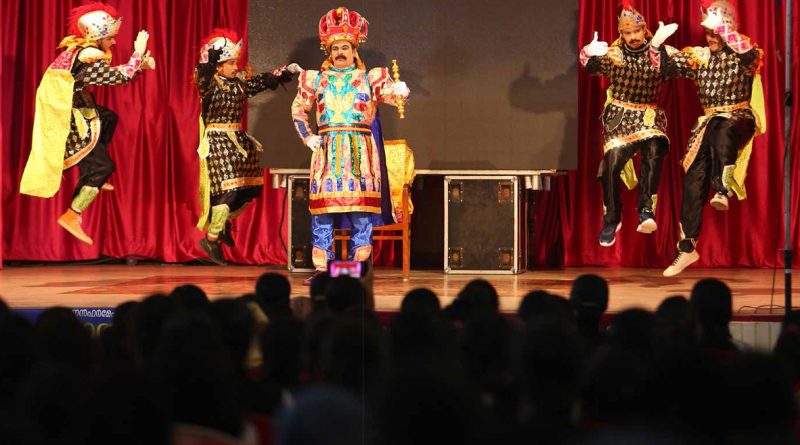Gothuruth- The Isle of Chavittu Naadakam
-Biju Muthathi
Senior Journalist
Cross the northernmost tributary of the Periyar river flowing through the district of Eranakulam, and you reach the isle of Gothuruth. Were anyone to set sight across the river, they would come across the Church and boat jetty of Gothuruth. Meanwhile, those from the Gothuruth side of the river can view the mystique ruins of the Portuguese fort and the Kottapuram Market. There are several ways to reach this beautiful Island. It is only a 5 km boat journey from North Paravur. Those from Kochi would need to traverse 30 kms and land at one of the many wharfs via Moothakunnamor Vadakkumpuram. You could also travel via land, as there are two bridges that were recently built. My choice would be to take a canoe from Muthakunnam. This way, you could set foot directly at the Churchyard, right into that land that carries the footprints of many generations of Chavittu Naadakam. Almost all the people of the 2000-acre Island of Gothuruth are Latin Catholics, engaging in vocations such as fishing, coconut farming, making coir products, and sand mining. After a tiring day, they often transform into Chavittu Nadakam performers, with costumes depicting kings, soldiers, clerics, and monks. This age-old life cycle, although tiresome to some, is routine for them, with Chavittu Natakam being the pulse of the island. In 1999, they were the flag bearers of a week-long Chavittu Natakam festival in Kochi, initiated by the State government, waking up Chavittu Nataka forums across neighboring isles like Chellanam, North Paravur, Kochi, and Kodungallur.
The five-day ‘Chuvadi’ fest in 2012 at Gothuruth, under the Kochi Muziris Biennale initiative, further strengthened Chavitu Natakam’s footholds. The 2015 season marked a significant moment when a crew first crossed the river to explore this mesmerizing art form, reflecting the central role it plays in the community’s life despite their struggles to make ends meet. A.N. Aniruddha Ashaan was our guide to the land of Chavittu Nadakam, a man who has performed Chavittu Nadakam across thousands of venues and has about 3,000 disciples all over Kerala. Having dedicated his life to the perfection of dance drama, Aniruddhan Ashaan’s songs are known for their unique singing styles, notes, and qualities. Starting his dance lessons at the age of 12 with his father, Natarajan, he became the best dancer in Kerala, learning from George Kutty Ashaan, a famous Chavittu Nadakacharya. Excelling as an actor and director, he trained children from all districts of the state, unmatched in agility of steps, expression, and perfection of presentation. Aniruddhan Assan’s works, like KarelsmanCharitam, Saint Geevarghese, David and Goliath, Death of Paryas, Anjalika, Satyapalakan, Sri Ayyappa Charitam, Dharmayudha, et al., were so well-mastered that he could recite any line from the plays he directed. As he stood solemnly at the boat jetty that day, gazing into the river, we witnessed a metamorphosis as he transmigrated across characters without any need for costume or makeup, performing in front of an imaginary crowd. The stage of Chavittu Nataka was the first drama stage in Kerala.

Visually similar tothe European opera, this ancient art form was anchored in Kerala and especially Gothuruth with the arrival of the Portuguese. The European missionaries who came to Kerala along with the Portuguese traders to spread Christianity, were the great admirers and advocates of Chavittu Natakam. Those artistes were also the messengers of the European Renaissance. They created Chavittu Natakam by combining it with the art traditions of Kerala like Kathakali, Koodiyattam, Kalari, Yakshaganam, Nattua and Therukooth. About three hundred years ago, the poet and scholar Chinnathambi Annavi who came from Tenkasi in Tamil Nadu is heralded as the patriarch of Chavittu Natakam.
It is believed that he worked for Chavittu Natakam for nearly two decades in Kochi and Kodungallur. Chinnathambi Annavi was a Tamilian and the main reason why all the early ‘steps’ of Chavittu Nataka were in Senthamil. Or it could be because the progenitor of the Malayalam language is Tamil. In 1950, V J John Master from Fort Kochi produced the first Tamil drama ‘Caralsman Charitam’ in Malayalam. That’s how Malayalam steps started to spread. Sebina Rafi, who was the wife of the famous Malayalam writer Ponjikara Rafi, was known as the Rafi freed Chavittu Nataka from religious walls and made it an art for all Malayalis. The book ‘Chavittu Nadakam’ written by Sebina Rafi in 1964 is still the authoritative book on the history and culture of this art form.
In the 1960s, when Chavittu Natakam was staged as part of the Republic Day celebrations, Chavittu Natakam started gaining national fame. At that time, Prime Minister Jawaharlal Nehru praised the artistes and was seen standing on the stage wearing the Chavittu Nataka crown that they had gifted him. Besides Chavittu Nadakam, theisle of Gothuruth was also well known for its famous ‘Gothuruth Vallamkali ‘. This boat race which is held as part of the yearly festivities at Kadavaathuruthu Holy Cross Chruch, is the oldest water festival in Ernakulam district. The Ashaans dusted off every ‘step’ handed down from their ancestors. Paulose Ashaan, Pathrose Ashaan, George Kutti Ashaan, Simon Ashaan, Mickle Ashaan and Anirudhan Ashaan, all stepped forward again into the limelight. Adorned in their motley colored costumes and crowns, they transformed Gothuruth yet again into a 2000 acre Chavittu Nadaka stage! There is a statue of Chinna Thambi Annavi, the patriarch of Chavittu Natakam, in Gothuruth. No one who reaches Gothuruth returns without seeing it. It is a sole reminder, not only about Annavi, but also about those countless faceless artistes who sacrificed their lives for this beautiful dance drama form. Even as the Periyar river ebbs and flows through the eons of time, Gothuruth will have its identity etched in the sands of time through this unique artform. The colourful art form of Chavittu Nadakam!


